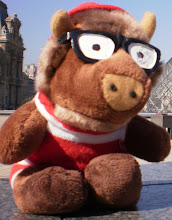Westminster Abbey, technically named Collegiate Church of St Peter at Westminster, has a long history. The original site held a small Benedictine monastery in 960 AD. In the 1040’s, King Edward the Confessor decided to renovate and expand the monetary to create the abbey we know today. It was named “west minster” to distinguish it from St Paul’s Cathedral (the east minster) in the City of London—and apparently the name stuck.
The abbey underwent another major renovation in the 13th century when King Henry the 3rd rebuilt it with the Gothic style of architecture Thundar saw in London this fall. In addition to a place of worship, the abbey was designed to be a burial place for monarchs (and other famous people) and a place for coronations to take place.
 |
| Look closely--Thundar is hiding in there! |
Built in 1858, Big Ben is the largest four-faced chiming clock and the third-tallest free-standing clock tower in the world. The tower is connected to the Palace of Westminster, which is also known as the Houses of Parliaments (plural because it includes the House of Lords and the House of Commons—England’s two chambers of parliament). The clock tower was an impressive sight, especially at night when the face lit up brightly with the London Eye ferris wheel glowing blue in the background.
-Alyda


No comments:
Post a Comment